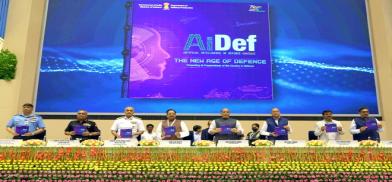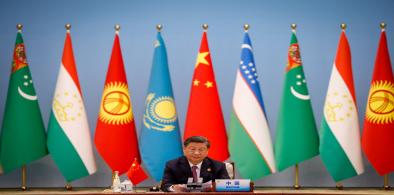With eye on China, India's armed forces incorporate AI systems in three services
In view of China’s build-up all along the Line of Actual Control (LAC) till Arunachal Pradesh, it is just as well that India is pursuing efforts to equip its armed forces with AI-backed systems

Seventy-five newly-developed Artificial Intelligence (AI) -powered technologies were launched by India's Defence Minister Rajnath Singh during the first AI in Defence (AIDef) symposium and exhibition organised in New Delhi where experts said have been developed on Chinese border build-up and regional muscle-flexing.
Also present were Minister of State for Defence Ajay Bhatt, Indian Navy chief, Admiral R. Hari Kumar, Indian Army chief, General Manoj Pande, Secretary, Department of Defence R & D and Chairman, Defence Research and Development Organisation (DRDO) Dr G Satheesh Reddy, Indian Air Force Vice Chief, Air Marshal Sandeep Singh, senior civil and military officials of the Ministry of Defence, envoys of many foreign countries, representatives of research institutes, academia and the industry as well as technology students.
Covering a wide range of fields and applications, these products include AI Platform Automation; Autonomous/Unmanned/Robotics systems; Block Chain-based Automation; Command, Control, Communication, Computer and Intelligence, Surveillance and Reconnaissance; Cyber Security; Human Behavioural Analysis; Intelligent Monitoring Systems; Lethal Autonomous Weapon Systems; Logistics and Supply Chain Management, Operational Data Analytics; Manufacturing and Maintenance; Simulators/Test Equipment and speech/voice analysis using Natural Language Processing, stated a government release.
AI products
Three AI products developed by the defence public sector undertakings (DPSUs) have dual-use applications and good market potential, namely AI-enabled Voice Transcription or Analysis software developed by Bharat Electronics Ltd; Driver Fatigue Monitoring System developed by Bharat Earth Movers Ltd and AI-enabled evaluation of Welding defects in X-rays of Non-destructive Testing developed by Garden Reach Shipbuilders and Engineers, were screened during the event.
These products are expected to open up new business avenues for the Defence PSUs, authorities said.
Also released by the Defence Minister were the physical and e-version of the book comprising the details of these 75 products, showcasing the collective efforts by the Services, DRDO, DPSUs, iDEX (innovations for defence excellence) start-ups and the private industry in last four years in the field of AI.
Expressing the hope that India will soon be among the leading countries in the field of AI, Rajnath Singh stated: "We have started incorporation of AI applications in remote piloted, unmanned aerial vehicles. There is a need to move further in this direction so that we can develop autonomous weapon systems. Timely infusion of technologies like AI and Big Data in the defence sector is of utmost importance so that we are not left behind the technological curve and are able to take maximum advantage of technology for our services."
Faster promotion of AI applications
He added that several MoUs have been signed with the industry for faster promotion of AI applications in the Services. Many AI-related challenges under the Innovations for Defence Excellence (iDEX) initiatives have also been given.
In view of China’s build-up all along the entire Line of Actual Control (LAC) till Arunachal Pradesh, it is just as well that India is pursuing efforts to equip its armed forces with AI-backed systems, officials said.
According to Yuan-Chou Jing, associate professor at the Graduate Institute of China Military Affairs Studies, NDU, Taiwan, who wrote ‘How Does China Aim to Use AI in Warfare?’ in The Diplomat dated December 28, 2921, one of the advantages of AI is to speed up military decision making.
PLA tactics
More specifically, AI is particularly fit for blitz tactics. In the scenario of the PLA waging a war against Taiwan, distance makes instant US reinforcement difficult. The PLA, therefore, would take advantage of speed in the attack so that it can demotivate any US intention to come to Taiwan’s rescue.
Taking advantage of AI, the PLA is expected to focus on algorithms, unmanned platforms and extreme domains and develop the intelligentized “assassin’s mace” weapons, mainly including precision guided missile, hypersonic glide vehicle (HGV), UAV, cyber attack, targeting vulnerabilities of US battle network systems, to exploit its relative advantages to fulfil Anti-Access/Area Denial (A2/AD).
It is also very likely to see the PLA apply AI to the domain of cognitive warfare. Cognitive warfare is a psychological approach which is in line with the traditional Chinese military wisdom that “the supreme art of war is to subdue the enemy without fighting” and “it is better to win the heart of the people than to capture the city”.
“When entering an intelligentization era, China will try to use much more advanced AI skill to fulfill the same cognitive warfare effort. Deepfake, for instance, is one AI technology currently being developed by China to generate fake news, even video and satellite pictures, against rivals in an attempt to misguide opponents and regulate public opinion at home and abroad,” stated Jing.
All-terrain vehicles
While China has reportedly inducted robots in Ladakh, including ones that are equipped with machine guns, the Indian Army will soon conduct trials of indigenously developed AI-enabled, unmanned all-terrain vehicles in Ladakh for surveillance and logistics operations and those trials will also be held in the deserts in Rajasthan before the Army selects a final product and goes for large-scale acquisition, The Print said in a despatch.
One of the vehicles under consideration, developed by the Kalyani Group that runs on both batteries and motors, was included in the 75 products on display at the MoD’s AI symposium. The vehicle is operable on battery for about six hours and on the motor for 14 hours, has an operational range of three km and can carry a load of up to 500 kg.
Additionally, day and night cameras, having a range of two km, are mounted on the vehicle, make it a great asset for infantry and armoured units.
Trishul, an AI-enabled and remotely-operated weapon station that can detect human movement, direct weapons and fire automatically, with the capability of engaging targets at 300 metres with 100 percent probability of first round hits is also under consideration.
Navy and AI
In 2020, the Indian Navy set up a state-of-the-art AI and Big Data Analysis lab in INS Valsura, a shore establishment at Jamnagar, Gujarat, which has already been designated as the Centre of Excellence in Big Data.
The Autonomous Fast Intercept Boat developed by the Indian Navy, a first of its kind, is 15.6 metres long and can cruise up to 25 knots in autonomous mode. It has been developed in close partnership with Bharat Electronics and Goa Shipyards Ltd under the government’s initiative. The boat has been designed to adapt to a multi-varied capability, which includes surveillance, countermeasures, and exploration among a few.
The Navy is also reportedly into natural language processing (NLP), wherein Mandarin, Hebrew and Russian voice-to-English tech solutions have been developed. It is getting into computer vision in face recognition, surveillance, image retrieval and biometrics. Several cases have been identified and are then progressed to enhance the war fighting capability of its platforms. The Navy has been able to transform 2D images of handwritten text into machine-readable text. In addition, complex algorithms can capture data and convert them into actionable information to be utilized for enhancing operational efficiency and efficacy.
IAF and AI
The Indian Air Force’s Centre of Excellence for Artificial Intelligence under the aegis of UDAAN (Unit for Digitisation, Automation, Artificial Intelligence and Application Networking) was inaugurated by its Vice Chief, Air Marshal Sandeep Singh, on July 9 at Air Force Station Rajokri, New Delhi. In IAF’s fifth generation fighter jet–F-22 and F-35 – the target engagement activities are heavily software-generated, covering up to 95 percent the entire combat activities. The cockpit is so filled with sensors and computer processors that Algorithms are already flying planes. The data received from the multi sensors-sub-systems forms the basis of such engagement.
However, that is also the biggest challenge for a pilot to read through and process the high-speed data in a complex air combat environment. Also, the Multi-Platform Multi-Sensor Data Fusion (MPMSDF) creates real-time awareness, integrating battlespace surrounding for the decision making.
In view of China’s opaqueness and sustained anti-India moves, both diplomatically and militarily, not only will India’s Armed Forces have to keep a sharp and constant watch on their Chinese counterparts, but its intelligence agencies will also have to ensure that they have their systems developed enough to counter the Chinese.
(The author, is a former Defence Ministry and Indian Army spokesperson. He can be contacted at wordsword02@gmail.com)




















Post a Comment